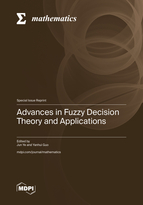Advances in Fuzzy Decision Theory and Applications
A special issue of Mathematics (ISSN 2227-7390). This special issue belongs to the section "Fuzzy Sets, Systems and Decision Making".
Deadline for manuscript submissions: closed (31 August 2023) | Viewed by 12942
Special Issue Editors
Interests: fuzzy theory and applications; soft computing; decision making theory and method
Special Issues, Collections and Topics in MDPI journals
Interests: image processing; medical image processing; pattern recognition; computer vision; data science
Special Issues, Collections and Topics in MDPI journals
Special Issue Information
Dear Colleagues,
There is a particular level of incompleteness and uncertainty in complicated decision-making problems. Thus, the fuzzy set proposed by Zadeh has been widely used in the field of decision making. Due to the need for better and detailed membership functions in real decision-making problems, classical fuzzy sets have been extended to type-2 fuzzy sets, hesitant fuzzy sets, multivalued fuzzy sets, cubic sets, intuitionistic fuzzy sets, Pythagorean fuzzy sets, spherical fuzzy sets, neutrosophic sets, etc. Each of them is attracting significant attention in decision making, with these fuzzy theories being used in various decision-making applications. In recent years, various fuzzy theories have made new progress and achievements in various decision-making problems.
The focus of this Special Issue is the extension and applications of advanced fuzzy theory to solve various decision-making problems. Articles submitted to this Special Issue can also be concerned with various advanced fuzzy theories, fuzzy decision theories and methods, and applications in decision making. We invite researchers to contribute original research articles and review articles, which will stimulate continuous research on various fuzzy theories, fuzzy decision theories and methods, and applications to solve various decision-making problems.
Prof. Dr. Jun Ye
Dr. Yanhui Guo
Guest Editors
Manuscript Submission Information
Manuscripts should be submitted online at www.mdpi.com by registering and logging in to this website. Once you are registered, click here to go to the submission form. Manuscripts can be submitted until the deadline. All submissions that pass pre-check are peer-reviewed. Accepted papers will be published continuously in the journal (as soon as accepted) and will be listed together on the special issue website. Research articles, review articles as well as short communications are invited. For planned papers, a title and short abstract (about 100 words) can be sent to the Editorial Office for announcement on this website.
Submitted manuscripts should not have been published previously, nor be under consideration for publication elsewhere (except conference proceedings papers). All manuscripts are thoroughly refereed through a single-blind peer-review process. A guide for authors and other relevant information for submission of manuscripts is available on the Instructions for Authors page. Mathematics is an international peer-reviewed open access semimonthly journal published by MDPI.
Please visit the Instructions for Authors page before submitting a manuscript. The Article Processing Charge (APC) for publication in this open access journal is 2600 CHF (Swiss Francs). Submitted papers should be well formatted and use good English. Authors may use MDPI's English editing service prior to publication or during author revisions.
Keywords
- fuzzy theory
- fuzzy decision theory and method
- decision making
- multicriteria decision making
- group decision making
- engineering and scientific applications






